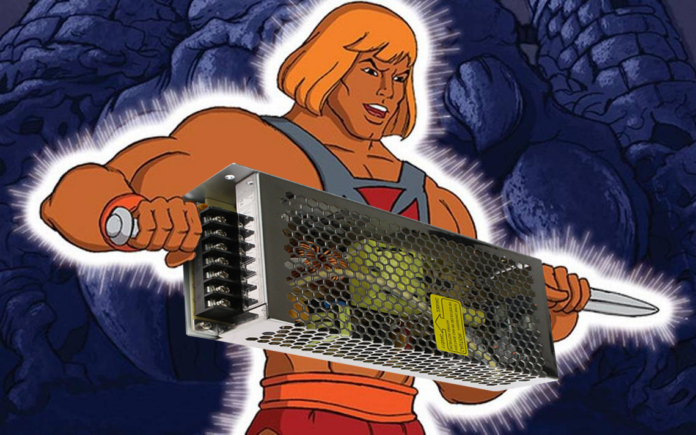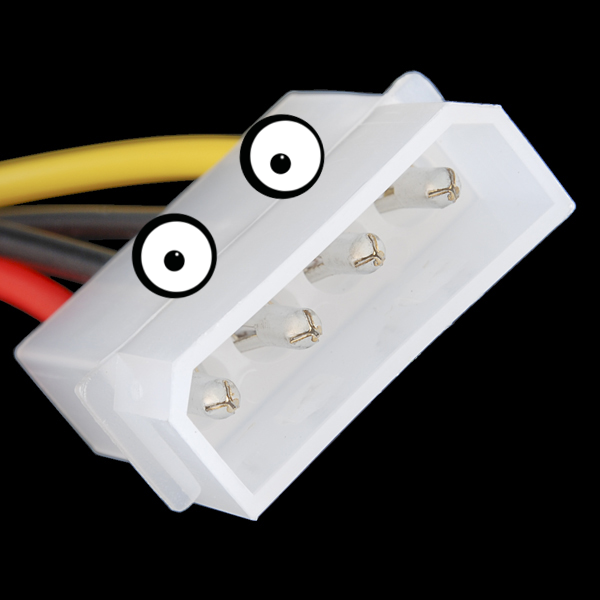
Well… or a PSU for any kind of PC. But we’ll pretend it’s for workstations only, and not some gaming rig [don’t even mention the word beginning with m- and ending with -ining], because if it’s a workstation, it’s obviously more useful and you’re a better human being.
So, in a much belated update to this sad attempt at a blog, we’ll be discussing power supplies, as I’ve mentioned at least twice already. Out of all the components in a workstation, this is one I probably get the most weird questions about, but it’s actually not that complicated, as you’ll soon see.
Let’s pretend for a moment you’re building a workstation [as in, building it yourself, like a boss, not having one built for you, like a total noob], you’ve got your CPU[s], GPU[s], bucketloads of RAM and more SSDM.2NVMEHDDs than you can shake a stick at. Sweet, so how do you power that beast?
The steps you need to take to choose a proper PSU are simple:
- Crush your enemies
- See them driven befo… wait. Wrong blog post….
Actually the basic stuff you need to think about is power, efficiency [maybe], connectivity and quality. We’ll go through all of those one by one. I’m not trying to make this a be-all end-all guide to PSUs, of course, more like a starting point to help you make an informed choice vs a choice pulled out from where the sun don’t shine. I’m a firm believer informed choices are good for you [and usually the people around you as well – see politics].
Here’s what’s Watt
Watts are [units of] power. Power is awesome. But unlike the one given to He-manperson by castle Grayskull, the power we are talking about is the “rate of doing work”. Or in a much more normal-human [ie. not physicist] friendly sense – the amount of energy spent per a specific interval to do “something useful” [known in physics as work, known to the rest of humanity as anything but work].

It’s worth noting the watt is named after James Watt, the inventor of the steam engine, without whom we wouldn’t have a platform to aggregate dozens of games we will never play or something alike.
In essence, the more watts you have, the more stuff you can cram into your workstation. But being sensible, environmentally and pocket friendly people, we don’t want to just buy the biggest, beefiest PSU on the market, since all that extra money can be used for something more useful. So to figure out how much power is the bare minimum for your system, you can use an online PSU calculator, such as the absolutely awesome one by OuterVision. [which is the same one you’ll get on the very top when you google “PSU calculator”, which totally means it’s the best one]
You’ll find a plethora of options there for all but the most unusual of hardware. Enter everything you plan to install in the workstation and voila, you’ll get an estimate how much power your config will need. This being a workstation, I recommend choosing “Always On 24/7” and “Game On 24/7” for Computer Utilization Time, and Gaming/Video editing/3D rendering categories respectively. [Note that you will also get a recommendation for a power supply you should get, but going with that without understanding why is a noob move so read on plz.]
Now this is a great time to think about the future. What happens if you later discover that you actually like GPU rendering, and decide to acquire some extra GPUs? Or you plan to later upgrade your CPU to something better? Obviously, you need a plan. Try to think ahead and see what kind of components you might realistically be adding, look up their power usage and add that to the power rating you have. Changing a PSU post festum is a total hassle, and not only is it expensive, depending on the case you have, you might be required to disassemble everything, and screw up all the beautiful cable management you totally spent hours on.
Now you know how much power you need, but to figure out how much power you want, we have to talk about efficiency.
For the awesome price of X+Y , we’ll give you X!
So, in the most basic of terms, the efficiency of a PSU is how good it is at taking AC [the Tesla stuff] power from the electrical outlet and converting it to DC [the Edison killing elephants stuff] which your components will happily devour. The rating [aka the number printed in giant letters on the box] is what your PSU is definitely capable of delivering. However, that same number is definitely not what the PSU will be drawing from the wall – it will always draw more.
Another important thing to note here, is that if you have a 600W PSU, that does not in any way mean it will draw 600W constantly. A PSU will draw only as much power from the wall as your components require and be happy to do so while said power is less than its rating. [If it’s greater, read again from the beginning]
Also, your components will not require the same amount of power all the time. A CPU or GPU under full load need much more power than when idle.
PSUs are fickle beasts though, and they have different efficiency ratings at different loads. Nowadays this is all thankfully standardized, and you can look at the 80 PLUS certificate on your chosen PSU to figure out exactly how efficient it is under which conditions. There’s various levels from Bronze all the way up to Titanium – the higher the level, the more efficient the PSU. Does it really matter all that much? Let’s see!
Generally speaking, PSUs are at their most efficient at around 50% load. To understand exactly how this works, imagine you have a workstation that at full load [like when rendering] needs 450W of power.
Now imagine you have three different PSUs to choose from, 500w 80PLUS Bronze, 800w 80PLUS Bronze, and a super fancy 900w 80PLUS Titanium.
The 500W PSU delivering 450W is at 90% of its rated load. The 80PLUS Bronze states the PSU will deliver power with at least 85% efficiency @50% load and at least 82% @100% load, so let’s assume it’s 82.6% @90% load [it is not exact, but we don’t care for this example].
This means your workstation will be drawing approx. 545W from the wall.
The 800W PSU delivering those same 450W is at 56% of its rated load. We can again assume the efficiency at that point is around 84,7%. [At the time of writing it’s 3 AM here, so I humbly ask you not to quote me on any of the math here, thx.]
So this setup will draw 531W from the wall. For the sake of simplicity let’s assume this computer will be used during office hours, and used as a renderslave the rest of the time, just so we can then oversimplify and pretend that it actually means it’s running 100% 24/7. Even in that crazy scenario, that’s a difference of just 14W or 0.014 kWh. Multiply that with 24*365 and you get 122kWh per year, or somewhere around 14$ in the US.
The 900w 80PLUS Titanium PSU however is at least 94% efficient @450W or 50% load. The power draw from the wall would then be only 478W. Compared to the 500W bronze, this PSU would save around 587kWh or $70 every year [or $56, obviously, when compared to the 800w 80PLUS Bronze].
Of course, except when looking at renderslaves in a very busy studio, the usage scenario will never be as simple, or as intense as the mental exercise above, so bear that in mind. I just wanted to demonstrate how the whole thing works. Depending on your power draw, the current PSU prices and the number of machines you plan on building, this may or may not be important to you.
Just in case you were wondering what happens to power drawn from the wall in excess of the actual load? It gets wasted. In the sense of ‘turns to heat’, not ‘goes out with the boys for one beer only’.
Get yourself connected
 When talking about connectivity, we’ll be considering two different things. The kind and amount of available connectors and if the PSU is non-modular, semi-modular or fully modular.
When talking about connectivity, we’ll be considering two different things. The kind and amount of available connectors and if the PSU is non-modular, semi-modular or fully modular.
A non-modular PSU has all the cables permanently attached to it [duh], while semi-modular PSUs usually have only the basic stuff pre-attached like the CPU connector [which, while we’re at it, is the one that usually connects to the top of the motherboard near the CPU, and 9 times out of 10 it being forgotten is the reason that I get calls like ‘Hey! I totally assembled everything but all I see when I power on is a black screen!’], a PCIe and the irritating fat one for the motherboard [aka 24-pin ATX]. If you need more than that you can use the provided cables to connect stuff.
A fully modular PSU has 0.00 cables pre-attached so you get to choose which, and in which order you’ll connect, which is the obvious choice of all teh pro PCMR builders out there.
Less cabling looks nicer, is much easier to manage, and also improves airflow. The latter can have quite an impact in small cases, for example. [However, in a cruel twist of fate, a lot of miniITX cases for all them VR boxes don’t play well with modular PSUs so take extra care!]
 Connection wise, there’s the standard stuff like PCIe cables which are important for the number of GPUs you plan to install, SATA for the drives and even ol’e Molex [which takes the prestigious award for ‘Stupidest Connector Ever Designed’ and needs to die a painful death]. There’s all sorts of combos out there, but in most workstation builds as long as you have enough PCIe power for the GPUs, you’re good.
Connection wise, there’s the standard stuff like PCIe cables which are important for the number of GPUs you plan to install, SATA for the drives and even ol’e Molex [which takes the prestigious award for ‘Stupidest Connector Ever Designed’ and needs to die a painful death]. There’s all sorts of combos out there, but in most workstation builds as long as you have enough PCIe power for the GPUs, you’re good.
The only tricky question here, this being a hypothetical workstation after all, is what happens if you have dual CPUs in your system? The CPU cable is also known as the EPS connector, and your PSU will need two of them if you want to power a dual socket motherboard. So don’t forget to check that!
QC passed
The final part of the equation is the quality of the PSU, meaning how internals are designed, manufacturing quality, parts used etc. In the days of old it was said you could know the quality of PSUs [and audio amplifiers] by how heavy they were. Nowadays it’s much more complicated, and the old superstitions don’t really work, if they ever did.
There’s far too much going on inside PSUs to summarize in a short overview such as this one. [And to be honest a fair share of it is also beyond the technical knowledge of yours truly.] However, what you should know is that much like with AIO water coolers, the brands you’re used to buying aren’t really manufacturing those units. Instead, they are usually made to order by several specialized companies like Delta, Fortron, Seasonic, Super Flower…
For example, Corsair’s high-end AX range is manufactured by Seasonic and Flextronics, depending on the model, while their more affordable CX range is made by CWT and Great Wall. You also might find yourself staring at a “Super Flower” PSU thinking what on earth is this Chinese crap, while in reality they produce units of outstanding quality and are behind some of the widely regarded EVGA PSUs, so don’t judge a book by its cover.
A PSU delivers 12V, 5V and 3.3V to power the different stuff in your computer. These different voltages are delivered via separate circuits [which may share some parts among themselves though] and the PCB traces all those wires connect to are referred to as rails. Each of these rails can sustain a certain maximum current. If you dig a little deeper you’ll see talk about single-rail or multi-rail PSUs. While a subject of much debate this 5 minute video from Linus sums up really well all you need to know:
[TL;DR: you really don’t need to waste time on that]
The easiest way to figure out all this voltage and current stuff is to think of electricity as a water pipe – you can think of the voltage as the water pressure, and the current [expressed in Amps] as the flow rate. The resistance [in Ohms] would then be the diameter of said pipe. To put it bluntly, the more amps your PSU can deliver on any given rail, the better, since that lessens the chance of the PSU shutting down if you have some particularly nasty hardware which under full load draws a huge amount of current. While virtually all power supplies today are made to withstand the needs of current hardware, and you don’t need to bother with it too much, just don’t expect the cheapest PSU you can find to reliably handle a massive amount of hardware under extreme loads, just because the big number on the box suggests it can.
Finally, once you’ve narrowed down your choices, the best way to be really sure if a PSU is good or not is [like with so many things in life] to listen to the people who know more about it than you. JohnnyGuru for example has hundreds of absolutely amazing in-depth PSU reviews on site and I recommend you check a few of them to get a feel for what really goes on inside a PSU.
All in all, a good, reliable PSU will keep your PC running for years and your components happy and fed. So play it smart and don’t just go out and get the first/cheapest PSU you see. Ok? Ok. :*
